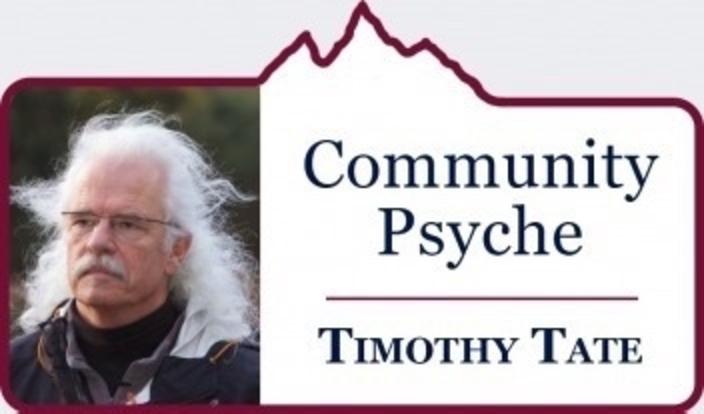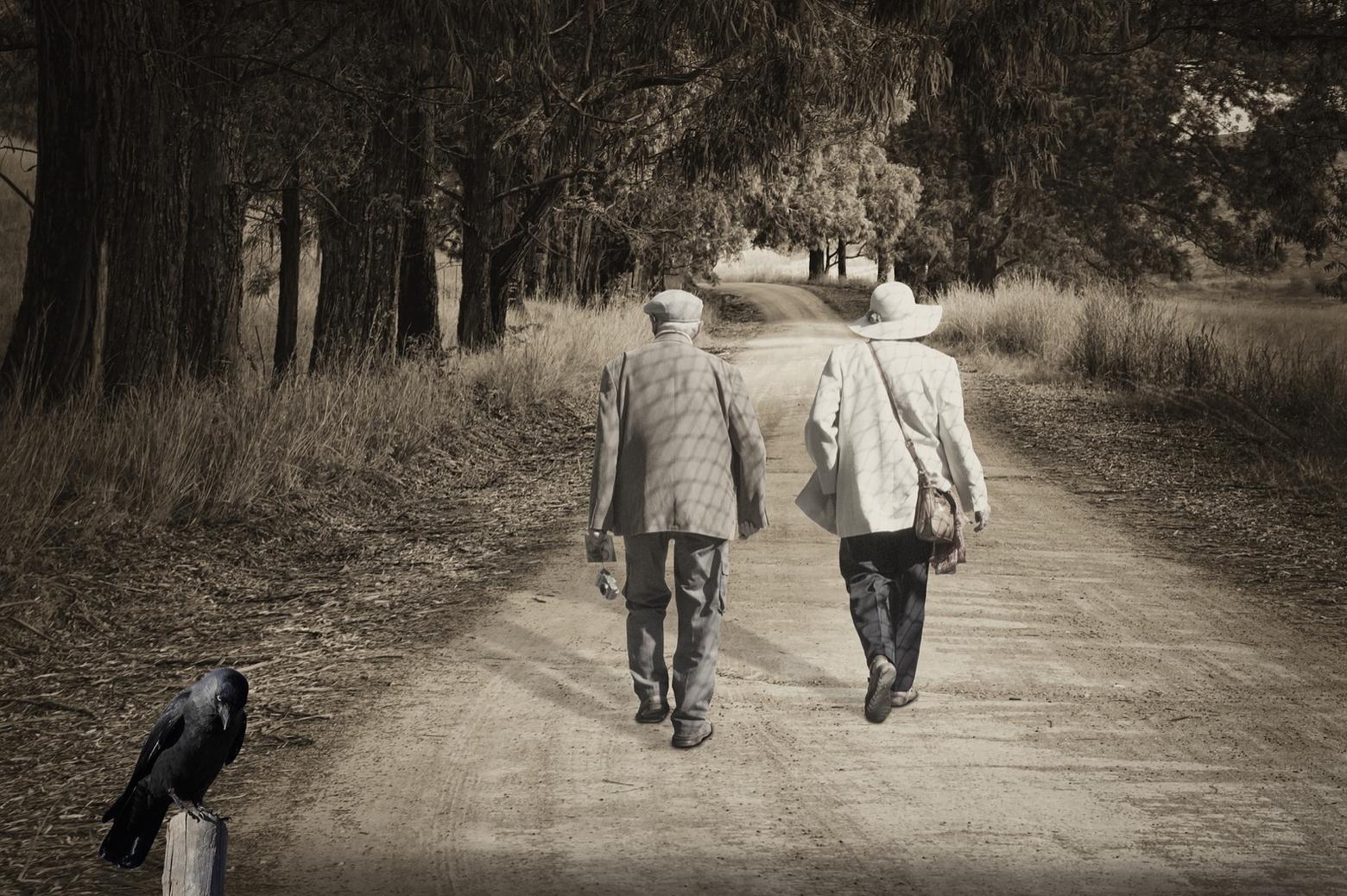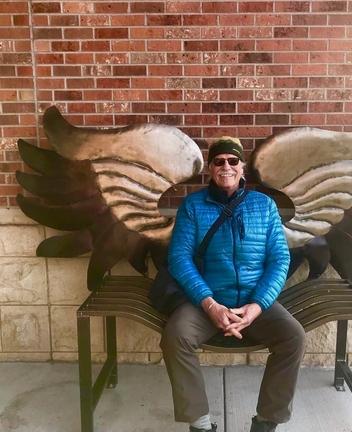Back to Stories
March 14, 2019
In The Winter Of Life, Dreams Prepare Us For What May Come
Getting old need not be a season of dread. As Timothy Tate says, it can be an opportunity to embrace who we are
The late American writer, conservationist, social commentator and agitator Edward Abbey, who has in recent years come under fire for his personal flaws as a white male, always identified, nonetheless, as a champion for underdogs, the human kind, plant and animal.
In a recent excerpt from his essay, “The First Morning” featured in the February 2019 edition of The Sun, Abbey observed, “I want to be able to look at and into a juniper tree, a piece of quartz, a vulture, a spider, and see it as it is in itself, devoid of all humanly ascribed qualities...even the categories of scientific description. To meet God or Medusa face-to-face, even if it means risking everything human in myself. I dream of a hard and brutal mysticism in which the naked self merges with a nonhuman world and yet somehow survives still intact, individual, separate. Paradox and bedrock.”
His message: we all are one. And I can tell you that, as humans, we thematically share the same kinds of dreams over and over again.
Many of our dreams are existential—about living or dying; or they offer narratives about our thoughts in relating to other people and the insecurities and fears we all have. Occasionally, they elevate our conscious awareness, enabling us to sensationally, without opening an eye or taking one footstep, experience the meaning of awe.
I am writing this column while sitting around a fire, after splitting wood well into my fourth cord of the winter. It is February 2019. My firewood guy retired from providing us with dry, seasoned split pine, after he delivered the final load to my single-car concrete driveway in mid-December. It was a bittersweet adieu. Now I am on my own.
I counted on his personal reliable service for 10 years. Watching an uncontested full cord, 4’x 4’x 8’, show up as agreed upon for a price that has held for years by an affable trustworthy friend is heartwarming in a Western-mountain-valley way. It’s an expression of an ethos dwindling behind the force of increased demand and price. I am not sure what the folks up at the mountain resorts are willing to pay for a cord before they decamp to their exclusive hideaways but I bet it’s more than the $190 Kris charged me.
According to my cell phone weather app it is now 3 degrees with a 15- mile-an-hour east wind making it feel like minus 16 degrees with 81 percent humidity to boot. The snow is coming down again, the variety that in cryogenic frigidity produces Montana’s legendary “cold smoke” power.
I have burned through two stacks of my mixed wood cord in the last two weeks. We have since experienced what some call the “snowmaggedon” with record dumps recorded for February. An international weather/temperature site states that we had the coldest March 3 anywhere in the world, registering a stiff minus-35 static air temperature, except for a weather station in Antarctica. The weather experts don’t know about Elk Park outside Butte, Montana. that recorded 41-below. We keep things to ourselves in the north country.
You may have also heard: the snow loads apparently helped cause the rooftops of two gymnasiums at Montana State University to collapse. We hear it all the time from snow birds that they leave the frigid north to escape the winter regimens of shoveling snow, though in a generation or two will it still be a part of our winters and will the sun birds in the desert be flocking here in larger droves to escape the extreme heat?
Sometimes, I wonder how many of these winters I still have left. Yes, it is an unpleasant thing to ponder one’s own senescence. Yes, where dreams and dreaming are concerned, we older citizens are being sent signals by our psyches as we move deeper into our own personal winters.
° ° °
Whether one today chooses to decamp to the desert or coastal California or remains and puts up with our still-harsh unforgiving mountain winters, there are inner tasks to be faced in negotiating our daily lives.
Those of us transitioning toward our final years often seek warmer climes to stave off the ravages of arthritis, aching muscles, stiffening joints and the sight of the end. The fatigue of such harsh weather and the demands of a frozen world— I, for example, could not roll down my iced-up driver’s window to make a drive-in deposit at the bank the other day—take a toll.
There are those among us who are invigorated by such extremes and others whose bodies slide into a pseudo-hibernation mode becoming sluggish and depressed. I know for myself as a septuagenarian that this mountain winter weather amplifies the hardships of aging but in a fashion that also intrigues.
Aging is like mountain weather—it ravages psychologically and it exhilarates. A folk saying goes like this: you warm yourself three times with firewood: cutting it, hauling it, and burning it. The crackling from our wood stove burning fir and pine while the flames lick at the stove’s glass doors fills me with warmth beyond the sixty-eight degrees it affords our living room. There is a fire within me as well that will not be vanquished by time or circumstance, but for some the flames are receding to a dimming flicker. All the while even as we sleep and drift off, we continue to dream.
I am astonished by the thundering demand of aging on my body and mind. It’s not like I can recover from this condition as I did from the demands of a long hike. It’s my reality as much as adolescent passion or young adulthood potential was. We all know where this is going. And in this sublime paradox of our molecules rejoining those with other manifestations of life on earth, referenced by Ed Abbey, lies the fire of astonishment. It burns knowing full well the outcome is being extinguished and it is healthy to find wonder in the absurdity.
Among those dealing with senescence, I see examples of wonder-filled courage every day along the Main Street of my town. For those of older persuasion who come behind The Blue Door of my practice and deal with their own “winters,” I encounter resiliency and the search for dignity.
What grabs my attention about aging in the mountains is that there is little room for error in pace, footwear, clothing, gear and calculating risk. If I ever find myself shuffling instead of striding, or foregoing opportunity rather than participating in over-snow ventures, then I am becoming old and will submit to its vagaries. There is, after all, a record of plenty of broken hips, sustained while slipping on ice, logged by elderly folk in the hospital ER.
But like my 86- year-old sister who will stride by her own funeral, I am convinced that aging converts to "old" when we lose the capacity to wonder. Like the other day when I awoke, I was amazed to have this precious gift of being alive.
This is not to say that I don’t sit on the edge of my bed and hold my head in my gnarly hands and summon the strength to arise and face the day. Getting old is hard.
Nor is to say that should cancer return or complications from it stymie my capacity to walk the miles I do each day that I won’t sink into despair. But it is to say that my relationship to life is not contingent on my ability to keep up. And, if you are one of the Boomers with an AARP card you need to know that you are not alone. The question is what do we do about this stretch of life so that it isn’t squandered?
All of this brings me back to the dreamworld which we’ve explored together in a few earlier columns. My last two have rotated around dream themes—what they tell us— as will this one finish with them there.
One of the more profound incisive perspectives that dreams offer is to practice for and craft our individualized soul, which is to say put us in touch and in tune with who we really are. The non-material self; the spiritual side that often gets cloaked in the mask of projecting notions of what we want other people to see about us. But now, in old age, it is time to solidify the relationship with ourselves and, in so doing, it often leads to improved relationships with those most important to us.
It’s a gift to know who one is, our strengths and weaknesses, before we leave this world, and to embrace them. No longer is there a need to impress.
° ° °
The idea of dreams reflecting life stages stretches back to Heraclitus and was reintroduced and developed by my mentor James Hillman in his book The Dream and the Underworld.
Quoting Heraclitus: “The thinking faculty is common to all, but the soul has its own logos, which grows according to its needs.” Hillman takes up the theme: “By digesting and transforming the day’s remainders, according to the logos (intelligence) of the soul rather than to the laws of common thought, the dream-work makes an individualized soul.”
It is never too late in life to discover who you are and embrace the soul that is the essence of your unique spirit.
This would be all mildly interesting if not academic were it not for the way in which James fashioned his own departure. After cancer took its toll James asked his Connecticut carpenter neighbor to fashion a coffin from the white pine tree that grew on Jim’s property. Yes, he saw himself as being analogous to an arboreal totem and felt a kindred organic connection that wasn’t at all saturnine, though it does run counter to the death denial attitudes of modern living, so rife in many outdoor communities.
Both the tree and Hillman aged according to the circumstance of relationship to the land and the character of the material. Have you ever noticed how many of us marvel not at the tree rings, fiber irregularities and expressions of distressed wood rather than the generic, all-conforming trunks grown in tree farms? Beauty of wood is the result of trees that were confronted with, and persevered through, seasons of challenge
James would sit in his wheelchair and talk to his longtime friend while he hewed the wood into its coffin shape. Holding true to one's character through the aging process and into death is both inspiring and reassuring, he told me. To be a congruent person who lives like they speak and speaks from their life experience is the epitome of maturity and a reconciled life.
As Hillman writes, “The deformation, transformative work in dreams constructs the House of Hades, one’s individual death. Each dream builds upon that house. Each dream is practice in entering the underworld, a preparation of the psyche for death.”
Yes, our dreams help us prepare psychologically for making the transition.
Imagine, if you will, that our relationship to dreams is a practice in dying. How, you may ask, can this not be interpreted as morbid?
Essentially, we are saying that from the perspective of dreams we are cultivating a soulful relationship to the invisible world, a whopping 95 percent of the cosmos. What is invisible matters, like the negative space in a painting that accentuates all that we see.. What you and I “see” in our dreams is not really “there,” right. But it does lead us to question what we mean by “real.” As in, does meaning only come from things with which we have a tactile physical connection?
Spoiler alert: it is not only about the couch you might be sitting on right now while you read this column. Nor is it about mangling dream content to confirm some rational “upper-world” meaning. Dreams tend not to be literal and they are not read as a self-help book that analytically, step by step, marches you through the paces of departure from life.
Dreams involve a nightly experience with the world of images that can lead to revelations. I was so moved by the movie Pan’s Labyrinth in many ways. Tears rolled upon seeing the cinematic conclusion of some heavenly assemblage greeting the girl as she crossed over. Mind you, it wasn’t the playing off of the heavenly host scene that got to me but rather it was the representation of illuminating the other-worldly images, welcoming our psyche home into a realm of… peace.
Lest we we circle the drain of dread let me remind of the creative challenge implicit in a life well lived: It is through respecting the grain of each life’s unique cut that aging finds its place. In each of us there are those grains to be identified and cherished. Trust me, you are unique.
Now, as I study the wood brought to heighten the warming fire in my stove, I am drawn to the rough surface, growth lines and bark of a gnarled tree once hit by lightning but still supporting its limbs’ reach. I take comfort in the lichen’s variegated hues as they spread centimeter by square centimeter every fifty years. What did the tree see as the world spun round?
Getting old doesn’t have to mean capitulating to fading away. I am inspired by characters like James Hillman, and by Ruth Bader Ginsburg who refuses to accept stereotypes of gender, accepted norms, and intimidation by roughnecks. Whatever dreams fuel Ms. Ginsburg’s small wiry body and keen mind you can bet she listens and pays attention to a voice that only she can hear.
In other words, curating our unique character—being attentive to our own peculiarities and idiosyncrasies— feeds our soul and our nightly dreams cultivate our relationship to Psyche’s way of inhabiting the images that transcend mortal aging and dying.
Embrace what your dreams are telling you. Write them down. Muse upon them while wide awake. Share the visions with your friends and loved ones, if you feel inspired. They rank among the most potent, deeply personal parts of the human experience and they can serve as our guide in journeying through the seasons of our lives. Heeding our dreams only primes the pump of excitement for whatever dreams may come.
PLEASE SUPPORT US: Mountain Journal is committed to giving you free reads you won't get anywhere else, stories that take time to produce. In turn, we rely on your generosity and can't survive without you! Please click here to support a publication devoted to protecting the wild country and the wildlife you love.






